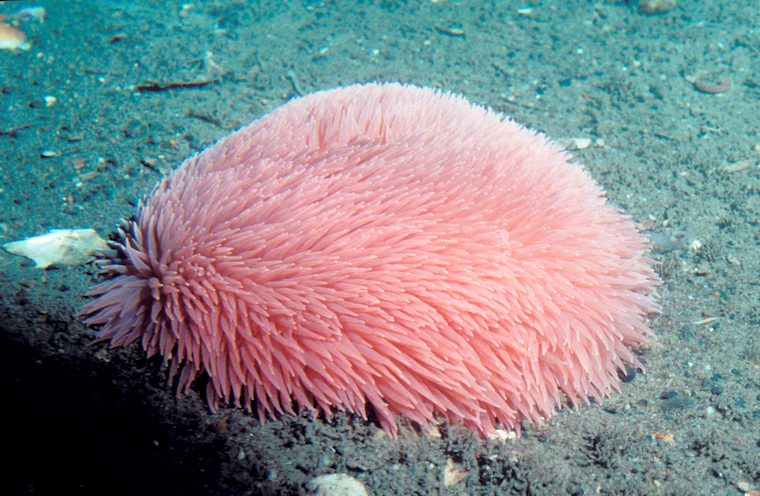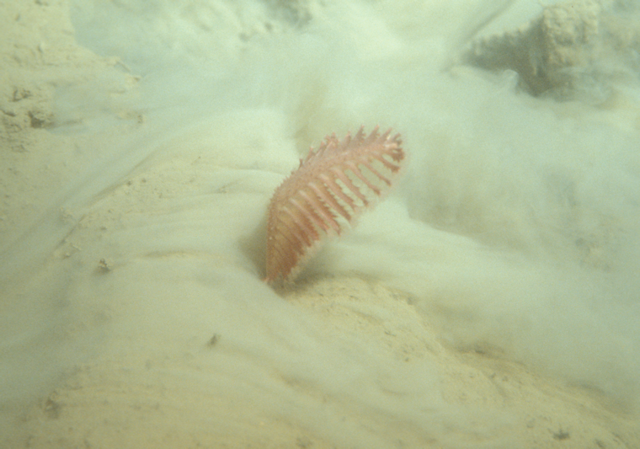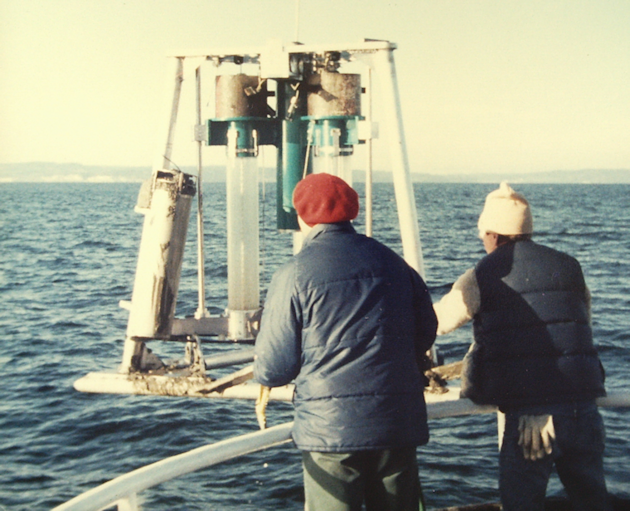Gulf of Maine Projects
For centuries, the Gulf of Maine has been recognized as a highly productive ecosystem with a rich fisheries. One example of this is that well before Europeans discovered the Americas, substantial shell-fish harvests by Native Americans were a strong part of their prehistoric heritage. Also, well before Christopher Columbus arrived in the new world, Basque and Portuguese fisher-folk were catching cod and other fish from the the Grand Banks and perhaps Georges Bank and the Gulf of Maine.

A pom pom anemone (Liponema multicornis) from the deep Gulf of Maine is rarely found and much more rarely photographed. (Photo by R. Langton.)
The scientists at New England Oceanographic Laboratory have been studying the productivity of the Gulf of Maine ecosystem. A primary concept in marine ecosystems is that plant growth in the sunlit surface layers of the oceans supplies the organic material which sustains all other biota of the ecosystem. While many species feed directly off the plants growing in the sunlit zone, other species live at various depths below the near surface. (Here think of lobster, scallops, and haddock). This proliferation of biota at depth is possible because most marine-produced organic matter, particularly the remains of organisms with shells or carapaces, is heavier than water and ultimately will sink down through the water column. Organisms living at depth in the sea must survive by feeding off of this downward rain of material, either by directly eating this material or by hunting and eating those other organisms that directly consume the sinking material. Sinking stops when the organic matter reaches the sea-floor. Here, a rich ecological community abounds in the Gulf of Maine and is fed by the continual rain of sinking organic matter from the sea surface.

A sea-pen on the deep sea floor or Gulf of Maine. This species captures in its fronds any small organisms that float by. The dusty flows around the sea-pen were caused by the submarine’s propellers. (Photo by R. Langton.)
To better understand how the ecosystem functions in the Gulf of Maine, we have studied how quickly this material is consumed at different depths. One study evaluted the respiration rate of microplankton (those organisms with sized from about 0.5 to 10 micrometers) at various depths below the euphotic zone. The decrease in the respiration rate with increasing depth was similar at many sites across the Gulf (see the Tab, Literature / Gulf of Maine). Another set of studies evaluated the rate of organic matter consumption by the sediments and compared these rates with the productivity of the surface waters (see Literature / Gulf of Maine). That study found that sediments received less sinking organic matter as the water column depth increased. So sediments found at 50 m water depth consumed about 26% of the productivity while those at 200 m water depth consumed about 9% of the productivity. These percentages constrain the amount of bottom fisheries that could occur in the Gulf.
Organic matter consumption within the sea-floor sediments is a complex interaction between organisms with differing metabolic forms of biochemical energy production. One set of interactions profoundly effects how nitrogen is converted within the sediments. To understand the unusual nature of sediments, let’s first describe the situation in a simpler ideal open-ocean water column. In the water column, the nitrogen contained within proteins in the sinking organic matter is released to the sea waters when the organic matter is caught, consumed, and digested. Then specific species of bacteria in the water column convert this inorganic nitrogen into the most common form of usable nitrogen in the ocean, the compound nitrate. This conversion results in the deeper ocean waters having high concentrations of nitrate. When deep waters are mixed into the sunlit waters, this nitrate fuels additional growth of plants. Thus, a cycle is developed where plant growth takes up the nitrate supplied from the deep waters, part of this production sinks out of the sunlit layers and is consumed at different depths below the sunlit layers. Nitrate is produced and accumulates in the deep waters, and part of this gets mixed up into the sunlit layers.

A set of sediment cores from the coastal Gulf of Maine is taken aboard the research vessel. (Photo by J. Christensen.)
In the Gulf of Maine, consistent with continental shelf regions generally, the role of the sea-floor sediments alters the above ideal nitrogen cycle. Whereas other nutrients are regenerated into a soluble inorganic form in approximate match to their amounts in the sinking organic material reaching the sediments, the sedimentary nitrogen process converts much of the organic matter nitrogen into nitrogen gas (N2). Nearly all marine organisms are not physiologically or biochemically capable of taking up and using this compound (N2). Consequently, the sediments act to remove usable nitrogen from the ecosystem (by converting the usable nitrogen into N2) with the result that only minimal amounts of usable inorganic nitrogen (nitrate) are returned from the sediments to the water column. This has implications for the Gulf of Maine. By not returning usable nitrogen to the Gulf’s ecosystem, the sediments act to reduce the nitrogen available for plant production, thus, the sediments set a limit on the productivity which may occur in the Gulf of Maine. New England Oceanographic Laboratory’s scientists have investigated this process by showing that a significant proportion of nitrogen is missing from the deeper waters of the Gulf (see Literature / Gulf of Maine.)
Our scientists are currently working on additional projects within the Gulf of Maine, with the focus on better understanding of upcoming ecosystem changes in the Gulf of Maine. In one, a new study of the role of nitrogen loss by sediments is currently nearing completion, and it will examine the impact of this sedimentary process on influencing ecosystem change. Also, we are investigating the changing water circulation in the Gulf as this may impact ecosystem functioning.
If you have an interest in helping to support these projects, please view the Giving Tab of this website!
